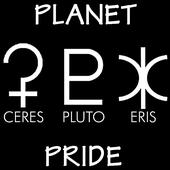My name is Jake W. I am an astronomy enthusiast and a beginner astro-photographer. I have always been fascinated by astronomy and the planets in particular.
Bookmark my blog or subscribe to it for the latest information on planetary science and related fields.
Despite the IAU's unfortunate decision on 24 August 2006 , I join many others in asserting that:
A PLANET is: ANY celestial object which,
1- Is not a Star.
(A body which can sustain a naturally occurring prolonged nuclear fusion reaction at some point in its life cycle. Bodies with a minimum mass of 13 Jupiters such as Brown Dwarfs, Stars, Pulsars, Stellar Remnants, [Super] Nova Remnants, Blackholes, etc.)
AND
2- Is of sufficient mass to have a shape determined by Gravity not the Strength of its Material.
(Overcoming rigid body forces and approaching hydrostatic equilibrium, a nearly spherical shape.)
"How big must an object be to be spherical? The Earth's moon is spherical. Jupiter's four moons discovered by Galileo are all large spherical objects, the smallest one being Europa with a diameter of 3,138 km; but these moons are quite big compared to the small moons of Saturn and Neptune and the few asteroids that have diameters of a few hundred kilometers. What intermediate-sized objects do we have in the solar system? Triton is a bit smaller, with a diameter of 2,700 km, and is clearly spherical. As illustrated in the figures, working our way downward in size from the Moon to Pluto and then to the moons of Saturn and Uranus, we find all of these, all the way down to Enceladus (diameter = 498 km), are spherical.
We do not have detailed images and therefore have not actually measured the three-dimensional shapes of the asteroids Ceres (diameter = 925 km), Pallas (diameter = 583 km), and Vesta (diameter = 555 km), and the ten largest known Kuiper Belt objects, Varuna (diameter = 760-1,040 km), Ixion (diameter = 900-1,230 km), 2002AW197 (diameter = 700-1,010 km), Quaoar (diameter = 1,300 km), 2002 TC302 (diameter = 1,200 km), 2003 EL61 (diameter = 1,500 km), 2003 UB313 (diameter = 2,700 km), Sedna (diameter = 1,500 km), Orcus (diameter = 1,400 km), and 2005 FY9 (diameter = 1,500 km). All of these objects, however, are substantially bigger than Enceladus, and many much bigger than Tethys (diameter = 1,060). The smallest of them (Pallas, Vesta) are rock and iron-rich asteroids, not balls of ice, and so are much denser than an icy moon of comparable size, like Enceladus. Without a doubt, therefore, we can assume that all of these objects are spherical.
The biggest, well observed solar system object below the size limit set by Enceladus is the Uranian moon Miranda. Miranda has a diameter of 472 km and is fairly well characterized as very nearly spherical; Miranda, though, has some rough edges. Some of Miranda's mountains, which are scars left by giant meteor impacts billions of years ago, reveal topographic relief that Miranda's gravity cannot quite pull back down. Saturn's moon Mimas is a little smaller, with a diameter of 398 km. As with Miranda, we might describe Mimas as nearly spherical, albeit with one enormous crater and an impressive amount of topographic relief. We might conclude, fairly and safely then, that 400 km is a good, though only approximate, boundary for sphericity. If an object is larger than 400 km, it will be best described as spherical or very close thereto; if the object is small than this limit, the object is likely better described as triaxial.
This 400 km limit is not perfect or even one-size-fits-all. For example, if one object is made of rock and iron and a second object of the same size is made of ice, the self-gravity of the rock and iron-rich object will be three to five times greater than the ice ball and the resulting pressures in the core of the object will be comparably greater. Since an object's own gravity is the force that squeezes it into a spherical shape, the more massive, rock and iron-rich object is more likely to be spherical than is the less massive, icy object.
In the outer solar system, the moons – like Miranda and Mimas – are dominantly made of ice, and so our 400 km limit was found for relatively low-mass (or low-density) objects."
Weintraub, David A. Is Pluto a Planet? A Historical Journey through the Solar System. Princeton University Press: Princeton and Oxford, 2007 CE.
Period. That's all that a Planet is. What its position is, what its composition is, what its orbital elements are, these don't make or break a planet. They are ways of further classifying a planet. Take a page from our friends in the biological sciences. They have taxonomy, a way of grouping life forms together based on broadest similarities first, then separating them down into more and more specific specialized groups based on a comparison of differences and similarities. Planet could be astronomy's analogue to an "Order or Family" of objects which are then refined down to various "Species" of Planets.
If you haven't yet, please sign the Save Pluto Petition. Show your planet pride. Save Pluto!
